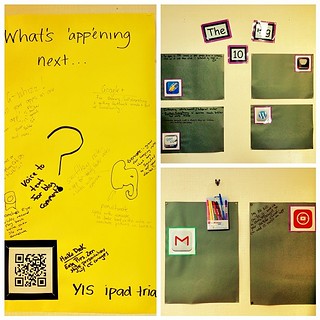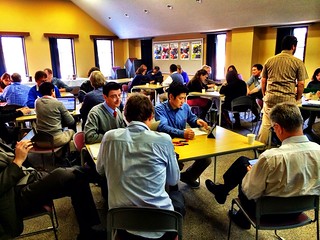Note: this is the second post in a series about our 2:1 (iPad Mini + MacBook Air 11″) trial at YIS. Check out the first post here.
Over this past semester we have steadily been working towards the next stage of our Connected Learning Community: moving 2:1 with an iPad Mini + MacBook Air for each student in grade 7 (for now). We’ve started by working with all of our grade 7 teachers in lots of different ways to ensure that they have the support they need to be successful with both devices. Here’s what we’ve done:
Grade Level PD
To kick off the trial with our teachers we had two grade level meetings (part 1 & part 2) in late January – not as easy to schedule as it sounds because (in a secondary school of about 45 teachers) we have 28 teachers of grade 7, plus all department heads, and all admin at these meetings. The scheduling challenges were worth it, though, to have everyone in the same room, hearing the same message, and experiencing the same introduction to the trial.
Our focus during these two meetings was to:
- give a clear overview of what we are doing and why, along with a timeline,
- help teachers get settled with their new iPad with mini-SpeedGeeking, a scavenger hunt (thanks to Dana for this genius idea!), and a demo slam,
- start thinking about the different ways we can use the iPads with our existing laptops to enhance learning,
- encourage sharing & feedback throughout the process.
To keep the grade level team learning together, before we left for spring break, we came back together as a seventh grade team and shared some highlights from our learning over the past months. Teachers had a chance to connect with participants from every other team (jigsaw-style) to get an idea of what the other teams had explored. As part of this sharing, each jigsaw group made suggestions for further PD, as well as ideas for new apps to add to our (then) essential 8 list. From this feedback, Clint and I were able to revise our essential 8 to the “big 10” apps, and to continue developing ideas for future teacher PD.
Informal Team-Based PD
 At our initial meeting, we asked teachers to think about the goals they have for working in a 2:1 environment. Based on those goals, as well as their skill level and comfort with other teachers, they formed their own teams of 4 – 5 teachers. The purpose of these smaller teams was to encourage informal sharing throughout the trial. We asked them to set a weekly or every-other-week meeting time so they could come together and share. Each team was asked to document their thinking in whatever format worked for them, and then to wrap up their discussions at the end of the trial in a blog post on our collaborative blog. Although we couldn’t make it every time, Clint and I attended at least one or two of these meetings for each of the 9 teams.
At our initial meeting, we asked teachers to think about the goals they have for working in a 2:1 environment. Based on those goals, as well as their skill level and comfort with other teachers, they formed their own teams of 4 – 5 teachers. The purpose of these smaller teams was to encourage informal sharing throughout the trial. We asked them to set a weekly or every-other-week meeting time so they could come together and share. Each team was asked to document their thinking in whatever format worked for them, and then to wrap up their discussions at the end of the trial in a blog post on our collaborative blog. Although we couldn’t make it every time, Clint and I attended at least one or two of these meetings for each of the 9 teams.
The fact that these teams were very informal, and that teachers created their own teams made the meetings very relaxed, open and productive. For the most part, teachers felt really comfortable sharing and learning together. The meetings I sat in on included lots of laughter, exploring apps, and brainstorming how they could be used during the trial period. Lots of these conversations also continued into the staff room, which helped spread enthusiasm across different groups.
Also in the staff room, we (actually, superstar PE teacher Alex Thomas did this for us) put up simple brainstorming posters for teachers to share tips and tricks with our original “essential 8” apps (now the “big 10”), as well as ideas for new apps.
Formal Team-Based PD
In addition to the more casual weekly meetings, we wanted to make sure that all teacher teams had a more formal opportunity to learn together, facilitated by either me or Clint (depending on who was available). Each team of 4 – 5 teachers were given a half day of release time to further explore their use of the iPad, as a companion device to our existing laptops. At the start, we thought each team may want a different session based on their subject area of interest or their skill level, but we found quickly that this proposed agenda template actually worked really well for all teams.
The focus of each meeting was:
- getting to know our (then) essential 8 apps
- what do we want students to know and be able to do (during the trial time), how do we traditionally get there, and how can we take advantage of the iPads to enhance that learning experience
- how can we create a streamlined and effective learning environment with multiple devices and the use of air server
- finding and vetting new apps to add to our list
From these conversations we realized a few important things:
- Taking the time to focus our professional development on the learning outcomes we would like to see for our students was a very valuable process – and sometimes challenging because of the desire to discuss the apps over the learning process.
- Selecting 10 apps that can work across subject areas helped teachers see the power of the iPad for reflection, documentation, sharing and collaborating (rather than focusing solely on content delivery).
- Many of our groups were mixed-department, which made for much richer conversations that could focus on the overall goals for trial (enhancing learning), rather than getting bogged down in subject-specific or department-specific challenges.
- We are going to need to continue to refine our list of “big 10” apps as teachers and students come up with exciting new ways to use their iPads – every conversation I had inspired tons of new ideas for how we help students share their thinking with each other.
Sharing & Reflecting on Teacher Learning
 As with every school, our teachers are busy people. We are conscious of the fact that they have lots of things going at once, and even with the enthusiasm over getting a new iPad, we know we need to be as clear and streamlined as possible in our communication and expectations. So, we set up a collaborative blog for all teachers to contribute to over the course of the trial.
As with every school, our teachers are busy people. We are conscious of the fact that they have lots of things going at once, and even with the enthusiasm over getting a new iPad, we know we need to be as clear and streamlined as possible in our communication and expectations. So, we set up a collaborative blog for all teachers to contribute to over the course of the trial.
This blog is also where we share the updates about the trial, agendas and minutes for meetings, and all related resources. Since we just introduced the iPads to the students last week, I’m hoping that we’ll see some documentation and sharing on the blog in the next few weeks. We’ve also organized a meeting agenda template in our collaborative Google Drive folder for all minutes of both the formal and informal PD – which should be a good way to document the thinking of each teacher group. Finally, we have an iPads@YIS Diigo group (with an RSS feed on the shared blog) that all teachers can join to share resources they come across.
Next Steps: Connecting with the Community
We’ve had some great conversations with teachers over the last few months. It’s absolutely fantastic to see the enthusiasm and excitement over this new development continue through some major school events (MYP Authorization and Next Chapter Training, various breaks, exams, and tons of PD hosted at YIS including #edcamp, #beyondlaptops, COETAIL final presentations). In recent weeks teachers have started sharing their unit plans with us, suggesting new apps that they have explored with their teacher PD group, and, of course, continued sharing ideas and resources with each other in the staff room.
In addition to working with teachers, we also wanted to make sure that all stakeholders felt involved in the implementation and outcome of the trial. In my next post, I’ll share how we structured our Community Focus Group (of teachers, students and parents), and then our iPad Institute for students.
From what I can tell, we’re one of the only schools in the world (the other being The Avenues School in NYC) that is implementing this kind of 2:1 program… has anyone else tried anything like this? Any suggestions?
Images:
- Staffroom wall by superkimbo, CC licensed on Flickr
- Teachers sharing their learning by superkimbo, CC licensed on Flickr





One thought on “The Evolution of a Connected Learning Community: Teacher Edition”